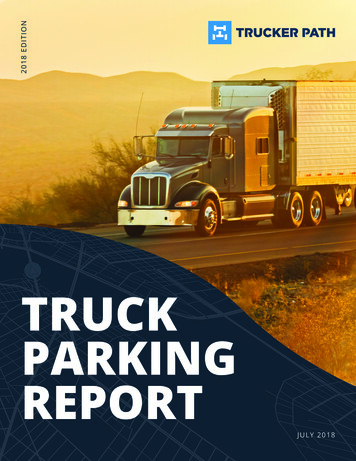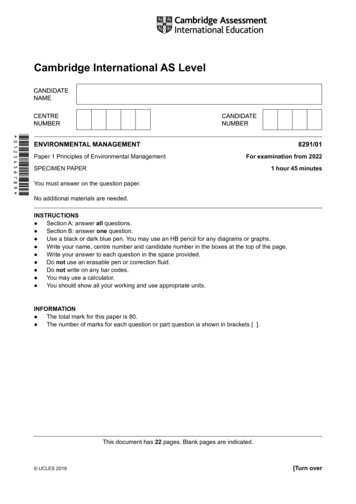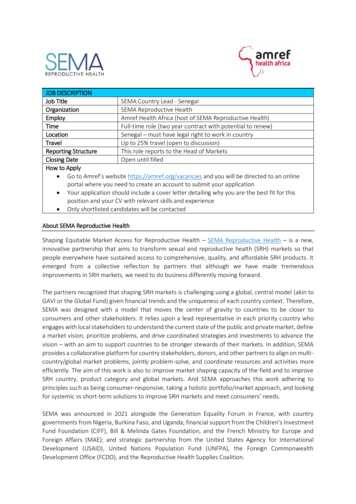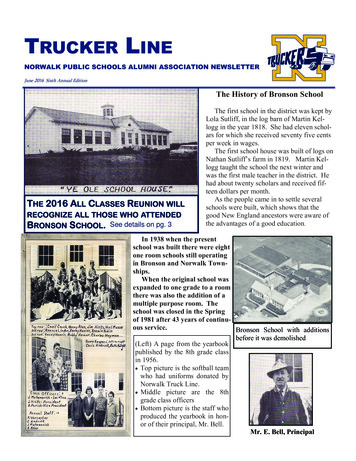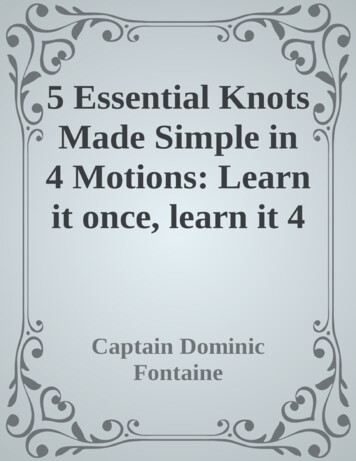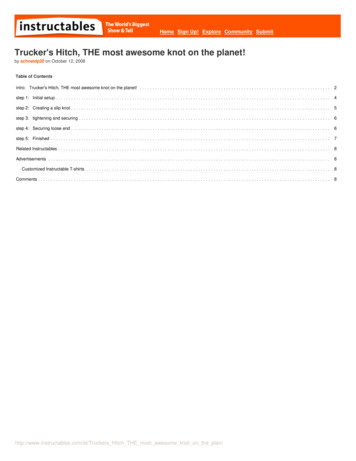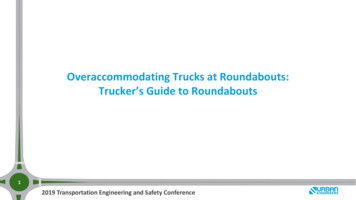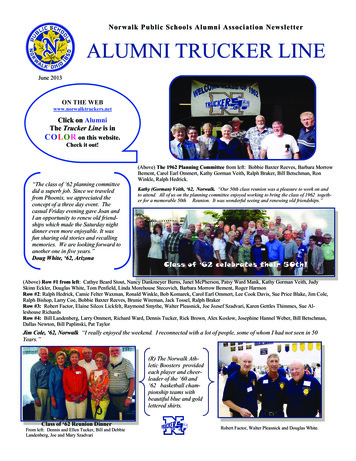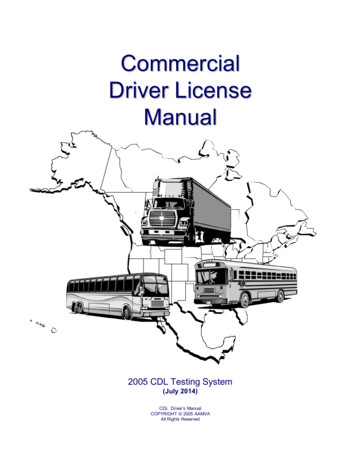
Transcription
CommercialDriver LicenseManual2005 CDL Testing System(July 2014)CDL Driver’s ManualCOPYRIGHT 2005 AAMVAAll Rights Reserved
This material is based upon work supported by the Federal Motor CarrierSafety Administration under Cooperative Agreement No. DTFH61-97-X00017. Any opinions, findings, conclusions or recommendations expressed inthis publication are those of the Author(s) and do not necessarily reflect theview of the Federal Motor Carrier Safety Administration.COPYRIGHT 2005 AAMVA. All rights reservedThis material has been created for and provided to State Driver License Agencies (SDLAs) by AAMVA for the purpose of educating DriverLicense applicants (Commercial or Non-Commercial). Permission to reproduce, use, distribute or sell this material has been granted toSDLAs only. No part of this book may be reproduced or transmitted in any form or by any means, electronic or mechanical, includingphotocopying, recording, or by any information storage and retrieval system without express written permission from the author / publisher.Any unauthorized reprint, use, distribution or sale of this material is prohibited.
INDIANA SPECIFIC COMMERCIAL DRIVER’S LICENSE APPLICANTINFORMATIONMost operators of Commercial Motor Vehicles (CMV) must have a Commercial Driver’s License (CDL). Some individuals arenot required to hold a CDL to operate a CMV. This exception applies to certain military personnel, farmers, firefighters,emergency response vehicle operators and individuals removing snow and ice. For exception details and requirements, review49 CFR 383.3.To obtain a CDL, the applicant must provide a valid Medical Examination Report for Commercial Driver Fitness Determinationand Medical Examiner’s Certificate (“Medical Report” and “Medical Examiner’s Certificate”), pass applicable vision andknowledge test(s), obtain a commercial driver’s license learner’s permit (CLP) and pass a CDL skills test at a Indiana Bureau ofMotor Vehicles (BMV)-approved CDL skills test site. This manual is a study guide for applicant requirements, passingknowledge tests and the CDL skills test.The manual and Medical Report and Medical Examiner’s Certificate may be obtained at myBMV.com or at any BMV licensebranch.Indiana requires all applicants for a CLP or CDL to provide a valid Medical Report and Medical Examiner’s Certificate. SeeMedical Report and Medical Examiner’s Certification sections for further information.Classes of Commercial Motor VehiclesApplicants must determine which CDL class for which they are making application. For information on classes of commercialmotor vehicles, review the following: Section 1 IntroductionCDL EndorsementsCDL endorsement codes and descriptions are listed below:Endorsement CodeTPNHXSDescriptionDouble/triple trailersPassenger transportTank vehicleHazardous materialsCombination of tank vehicle and hazardous materials endorsementSchool busFor additional information and testing requirements for CDL endorsements review the following: 1.1.1 – Knowledge Tests 1.1.2 – Skills TestSP 283 (R-11 10/15)
CDL RestrictionsCDL restriction codes and descriptions are listed below:RestrictionCodeEDescriptionReasonNo manual transmission equipped CMV (printeddescription on credential “auto transmission CMV”)KCDL intrastate onlyLNo air brake equipped CMVMNo Class A passenger vehicleNNo Class A or B passenger vehicleONo tractor-trailer CMVPNo passengers in CMV vehicleRVValid for restricted agricultural CDL privileges onlywhen presented with seasonal validation documentMedical varianceXNo cargo in CMV tank vehicleZNo full air brake equipped CMVApplicant takes the CDL skills test in a vehicle thathas an automatic transmission. (To remove thisrestriction, applicant must pass a skills test in a CMVwith manual transmission of the same class of vehicleor higher.)Applicant is restricted to operating in intrastatecommerce.Applicant does not pass the air brakes knowledge testor the CDL skills test in a vehicle with a full air brakesystem.Applicant takes a CDL skills test in a Class Bpassenger vehicle and holds a Class A CDL.Applicant takes a CDL skills test in a Class Cpassenger vehicle and holds a Class A CDL.Applicant takes the CDL skills test in a Class Avehicle that is not a tractor-trailer CMV.Applicants cannot transport passengers in a CMV buswhile holding a CLP with a passenger or school busendorsement.Applicant has a restricted CDL B for agriculturalpurposes.Applicant has an FMCSA approved medicalexemption.Applicant cannot transport cargo in a tank vehiclewhile holding a CLP with a tank endorsement.Applicant takes the test in a vehicle with an air overhydraulic brake system.Commercial Learner’s Permit (CLP)Below are the requirements for an applicant to obtain a CLP:1. Pay all required fees.2. Must be at least 18 years of age. (To operate in interstate commerce and/or apply for a passenger, school bus orhazardous materials endorsement, applicant must be at least 21 years of age.)3. Must have an unexpired Indiana license and valid driving privileges, and must not be subject to any disqualificationunder 49 CFR § 383.51. Must provide a valid Medical Report and Medical Examiner’s Certificate.4. Be a U.S. citizen or lawful permanent resident. Lawful permanent residents must provide a valid I-551.5. Must provide proof the applicant is domiciled in Indiana, as defined in 49 CFR § 383.5.6. Provide the names of all states where previously licensed to operate any type of motor vehicle during the previous 10years.7. Pass the vision screening with at least 20/40 vision in each eye.8. Have one year of driving experience.9. Pass one or more of the following knowledge test(s):a. General knowledge test for all applicants.b. Passenger transport knowledge test by all bus operators.c. Air brakes test knowledge operation of a CMV with air brakes.d. Combination vehicle knowledge test for combination vehicles.e. The tanker knowledge test for applicants required to haul liquids in bulk.f. The doubles/triples knowledge test to pull double or triple trailers.g. The school bus knowledge test by all school bus operators. (The passenger endorsement is also required forthe school bus endorsement.) Only the passenger endorsement is required for drivers delivering school busesnot transporting pre-primary, primary or secondary school students from home to school, from school tohome, or to and from school-sponsored events.
For issuance of a Class C CDL, the applicant must complete the testing requirements for the endorsement(s) passenger or schoolbus. Applicants wishing to obtain the Class C CDL with the hazardous materials endorsement will be required to apply for theClass B CLP to complete the CDL Skills Test in the Class C CMV.After an applicant has acquired the CLP, the applicant must pass a CDL skills test in a vehicle representative of the class ofCDL for which the applicant is applying. The CDL skills test must be taken at a BMV-approved CDL skills test site. A list ofBMV-approved CDL skills test sites can be found at myBMV.com or any BMV license branch.Applicants are only allowed to be issued a CLP for a total of 18 months in any 24 month period. A CLP is valid for 180 days.CDL Knowledge TestsIf an applicant fails a CDL knowledge test, the applicant may take the test again the next business day. An applicant must onlyattempt a CDL knowledge test once a day. Once the CDL knowledge test has been passed the CDL test results are valid for 180days.How to Transfer an Out-of-State CDLTo transfer an out-of-state CDL to an Indiana CDL, the applicant must meet the following requirements:1. Pay all required fees.2. Be at least 18 years of age. (To operate interstate commerce and/or apply for a passenger, school bus or hazardousmaterials endorsement, applicant must be at least 21 years of age.)3. Present documents of identification proving the applicant’s identity, Social Security number, lawful status, and Indianaresidency. A list of acceptable documents may be found at myBMV.com or any BMV license branch.4. Be a U.S. citizen or lawful permanent resident. Lawful permanent residents must provide a valid I-551.5. Have proof of an unexpired CDL and valid driving privileges.6. Pass the vision screening with at least 20/40 vision in each eye.7. Pass the operator’s knowledge test.8. Pass the general knowledge test.9. Pass the hazardous materials knowledge test, if applicable.10. Have one year of driving experience.11. Provide a valid Medical Report and Medical Examiner’s Certificate.12. Provide the names of all states where previously licensed to operate any type of motor vehicle during the previous tenyears.13. Surrender the CDL from the previous state of residency to the BMV.The CDL is an endorsement to an individual’s driver’s license. An applicant may choose to take and pass the chauffeur/publicpassenger chauffeur knowledge test if they desire to have the chauffeur’s or public passenger chauffeur’s license as their baselicense after meeting any additional requirements for that license type.Individuals have 30 days to transfer an out-of-state CDL.Medical Report and Medical Examiner’s CertificationCLP/CDL applicants and holders are required to:1. Provide a current, completed copy of the Medical Report and Medical Examiner’s Certificate for initial issuance.2. Maintain a current, completed Medical Report and Medical Examiner’s Certificate on file with the BMV to retaincommercial driving privileges.Medical Examiner RequirementsAll medical examinations must be completed by a medical examiner certified by the Federal Motor Carrier SafetyAdministration (FMCSA). You may locate a certified medical examiner by viewing the FMCSA National Registry of CertifiedMedical Examiners at https://nationalregistry.fmcsa.dot.gov.
Submitting the Medical Report and Medical Examiner’s CertificateA blank copy of the Medical Report and Medical Examiner’s Certificate can be downloaded at myBMV.com.The Medical Report and Medical Examiner’s Certificate may be submitted:1. By mail:Indiana Bureau of Motor Vehicles100 N Senate Ave, N481Indianapolis, IN 462042. By fax: 317-974-16133. In person at any BMV license branchIf you have questions regarding your medical certification or want to know the status of your medical certification, use yourmyBMV account to view your driver record. Individuals and companies may check this status by calling the Indiana BMV at888-692-6841.Exemption of Certain Medical ConditionsA person who is not physically qualified to operate a commercial motor vehicle under FMCSR 391.41 (b)(1) or (2) andwho is otherwise qualified to drive a commercial motor vehicle, may operate a commercial motor vehicle if FMCSA hasgranted a medical exemption to that person.For further information related to medical and health-related questions contact FMCSA at 800-832-5660.For additional information on medical exemptions, please review the following: 1.2 Medical Documentation RequirementsRetesting RequirementAny applicant with a CDL that has been expired, surrendered, disqualified, canceled, revoked, suspended or invalidated formore than one year, must pass all applicable knowledge and CDL skills test(s) as a first-time applicant.CDL Skills TestingAn applicant must hold the CLP 14 days prior to attempting the CDL skills test and appointments must be scheduled at least twodays in advance. The CDL skills test may only be taken once a day. An applicant is responsible for all costs each time thatapplicant has to take the CDL skills test. Once the CDL skills test has been passed, the applicant must visit any BMV licensebranch for issuance of the appropriate CDL.The CDL skills test results are valid for 180 days.If applicant fails any part of the skills test, to follow instructions or performs an unsafe action, this will result in an automaticfailure, ending the CDL skills test. They will be required to reschedule to take the CDL skills test again. Applicant is responsiblefor the CDL skills test fee and the truck rental fee, if applicable.It shall be within the discretion of the CDL skills test examiner to determine if an applicant has operated the commercial motorvehicle in a manner that was dangerous or unsafe causing an automatic failure.Once the applicant has passed the CDL skills test, they must return to the BMV license branch to complete the applicationprocess for the CDL prior to expiration of the CLP.For additional information on the CDL skills test, please review the following: Section 1.1.2 Skills Tests Section 11 Vehicle Inspection Test Section 12 Basic Vehicle Control Skills Test Section 13 On-road DrivingBMV-Approved CDL Skills Test SiteFor a list of BMV approved CDL Skills Test sites, visit myBMV.com or any BMV license branch.
Human trafficking is modern-day slavery. Traffickers use force, fraud and coercion to control theirvictims. Any minor engaged in commercial sex is a victim of human trafficking. Trafficking canoccur in many locations, including truck stops, restaurants, rest areas, brothels, strip clubs,private homes, etc. Truckers are the eyes and the ears of our nation’s highways. If you see aminor working any of those areas or suspect pimp control, call the National Hotline and reportyour tip:1-888-3737-888 (US)1-800-222-TIPS (Canada)For law enforcement to open an investigation on your tip, they need “actionable information.”Specific tips helpful when reporting to the hotline would include: Descriptions of cars (make, model, color, license plate number, etc.) and people (height,weight, hair color, eye color, age, etc.) Take a picture if you can. Specific times and dates (When did you see the event in question take place? What day was it?)Addresses and locations where suspicious activity took placeTrafficking Red Flags to Look for: Lack of knowledge of their community or whereaboutsNot in control of own identification documents (ID/passport)Restricted or controlled communication--not allowed to speak for selfDemeanor: fear, anxiety, depression, submissive, tense, nervousQuestions to Ask: Are you being paid?Are you being watched or followed?Are you free to leave? Come and go as you please?Are you physically or sexually abused? Are you or your family threatened? What is thenature of the threats?Report by Email: Report@PolarisProject.orgWarning: Please do not approach traffickers. Call the hotline, and they will call the FBI and localpolice to deal with them and rescue the victims. Approaching traffickers is not only dangerous foryou and their victims but could lead to problems in the eventual prosecution of traffickers. Go towww.truckersagainsttrafficking.org for more information.Make the Call, SaveLives.
Table of ContentsIntroduction . 1-1Driving Safely . 2-1Transporting Cargo Safely . 3-1Transporting Passengers Safely . 4-1Air Brakes . 5-1Combination Vehicles. 6-1Doubles and Triples . 7-1Tank Vehicles . 8-1Hazardous Materials. 9-1School Bus . 10-1Vehicle Vehicle Inspection . 11-1Basic Vehicle Control Skills Test . 12-1On-Road Driving . 13-1
2005 Model Commercial Driver’s License ManualSection 1INTRODUCTIONtrucking industry. Figure 1.1 helps you determine ifyou need a CDLThis Section Covers Commercial Driver License TestsMedical RequirementsDriver DisqualificationsOther Safety RulesInternational Registration ProgramThere is a federal requirement that each state haveminimum standards for the licensing of commercialdrivers.This manual provides driver license testinginformation for drivers who wish to have acommercial driver license (CDL). This manual doesNOT provide information on all the federal andstate requirements needed before you can drive acommercial motor vehicle (CMV). You may have tocontact your state driver licensing authority foradditional information.You must have a CDL to operate:Any single vehicle with a gross vehicle weightrating (GVWR) of 26,001 pounds or more.A combination vehicle with a gross combinationweight rating (GCWR) of 26,001 or more pounds,provided the GVWR of the vehicle(s) beingtowed is in excess of 10,000 pounds.A vehicle designed to transport 16 or morepassengers (including the driver).Any size vehicle which requires hazardousmaterial placards or is carrying material listedas a select agent or toxin in 42 CFR part 73.Federal regulations through the Department ofHomeland Security require a background checkand fingerprinting for the Hazardous Materialsendorsement. Contact your local department ofdriver licensing for more information.(Your state may have additional definitions ofCMVs.)To get a CDL, you must pass knowledge and skillstests. This manual will help you pass the tests,however, it is not a substitute for a truck drivertraining class or program. Formal training is themost reliable way to learn the many special skillsrequired for safely driving a large commercialvehicle and becoming a professional driver in theSection 1 - IntroductionVersion: July 2013Figure 1.1NOTE:A bus may be Class A, B, or C depending on whetherthe GVWR is over 26,001 pounds or is a combinationvehicle.Page 1-1
2005 Model Commercial Driver’s License Manual1.1 – Commercial Driver License Tests1.1.1 – Knowledge TestsYou will have to take one or more knowledge tests,depending on what class of license and whatendorsements you need. The CDL knowledgetests include:The general knowledge test, taken by allapplicants.The passenger transport test, taken by all busdriver applicants.The air brakes test, which you must take ifyour vehicle has air brakes, including air overhydraulic brakes.The combination vehicles test, which isrequired if you want to drive combinationvehicles.within a defined area. These areas may be markedwith traffic lanes, cones, barriers, or somethingsimilar. The examiner will tell you how each controltest is to be done.On-road Test. You will be tested on your skill tosafely drive your vehicle in a variety of trafficsituations. The situations may include left and rightturns, intersections, railroad crossings, curves, upand down grades, single or multi-lane roads,streets, or highways. The examiner will tell youwhere to drive.Figure 1.2 details which sections of this manualyou should study for each particular class oflicense and for each endorsement.What Sections Should You Study?LICENSEENDORSEMENTTYPE2XXX3XXXThe School Bust test, required if you want todrive a school bus.1.1.2 – Skills TestsIf you pass the required knowledge test(s), you cantake the CDL skills tests. There are three types ofgeneral skills that will be tested: Vehicle inspection,basic vehicle control, and on-road driving. Youmust take these tests in the type of vehicle forwhich you wish to be licensed. Any vehicle thathas components marked or labeled cannot beused for the Vehicle Inspection Test.Vehicle Inspection. You will be tested to see ifyou know whether your vehicle is safe to drive.You will be asked to do a Vehicle inspection ofyour vehicle and explain to the examiner what youwould inspect and why.Basic Vehicle Control. You will be tested on yourskill to control the vehicle. You will be asked tomove your vehicle forward, backward, and turn itSection 1 - IntroductionVersion: July 2013XXX4School BusXPassengerXTank VehiclesXDouble / TripleClass BThe doubles/triples test, required if you wantto pull double or triple trailers.Sections to StudyThe tank vehicle test, required if you want tohaul any liquid or gaseous materials in a tankor tanks having an individual rated capacity ofmore than 119 gallons and an aggregate ratedcapacity of 1,000 gallons or more that is eitherpermanently or temporarily attached to thevehicle or chassisHazardousMaterialsClass CClass A1The hazardous materials test, required if youwant to haul hazardous materials as defined in49 CFR 383.5.In order to obtain thisendorsement you are also required to pass aTransportation Security Administration (TSA)background tudy section 5 if you plan to operate vehiclesequipped with air brakes.Figure 1.2 – What to StudyPage 1-2
2005 Model Commercial Driver’s License Manual1.2 – Medical DocumentationRequirementsStarting January 30, 2012 and no later thanJanuary 30, 2014, if you are applying for a CDLPermit; or are renewing, upgrading, addingendorsements to a CDL; or transferring a CDLfrom another state, you are required to provideinformation to your State Driver’s License Agency(SDLA) regarding the type of commercial motorvehicle operation you drive in or expect to drive inwith your CDL. Drivers operating in certain types ofcommerce will be required to submit a currentmedical examiner’s certificate and/or any medicalvariance documents that you have been issued(i.e. Vision, Skills Performance or Diabetic waivers,or other exemptions) to your SDLA to obtain a“certified” medical status as part of your drivingrecord. You must contact your State DriverLicensing Agency (SDLA) to obtain informationregarding the requirement for submitting thesedocuments.If you are required to have a ”certified” medicalstatus and fail to provide and keep up-to-date yourmedical examiner’s certificate you become ”notcertified” and may lose your CDL.For the purpose of complying with the newrequirements for medical certification, it isimportant to know how you are using the CMV.The following information will help you decide howto self-certify:1.2.2 – Inter/Intrastate Commerce: StatusNon-excepted or Excepted?Once you decide whether you will operate ininterstate commerce or intrastate commerce,you must decide whether you will operate (orexpect to operate) in a non-excepted or exceptedstatus. This decision will tell you to which of thefour types of commerce you must self-certify.Interstate Commerce:You operate in excepted interstate commercewhen you drive a CMV in interstate commerce onlyfor the following excepted activities: 1.2.1 – Interstate or Intrastate CommerceDo you, or will you, use a CDL to operate a CMV ininterstate or intrastate commerce? Interstate commerce is when you drive a CMV: From one State to another State or a foreigncountry;Between two places within a State, but duringpart of the trip, the CMV crosses into anotherState or foreign country; orBetween two places within a State, but thecargo or passengers are part of a trip thatbegan or will end in another State or foreigncountry.Intrastate commerce is when you drive a CMVwithin a State and you do not meet any of thedescriptions above for interstate commerce.If you operate in both intrastate commerce andinterstate commerce, you must choose interstatecommerce.Section 1 - IntroductionVersion: July 2013 To transport school children and/or school staffbetween home and school;As Federal, State or local governmentemployees;To transport human corpses or sick or injuredpersons;Fire truck or rescue vehicle drivers duringemergencies and other related activities;Primarily in the transportation of propane winterheating fuel when responding to an emergencycondition requiring immediate response such asdamage to a propane gas system after a stormor flooding;In Response to a pipeline emergency conditionrequiring immediate response such as apipeline leak or rupture;In custom harvesting on a farm or to transportfarm machinery and supplies used in thecustom harvesting operation to and from a farmor to transport custom harvested crops tostorage or market;Beekeeper in the seasonal transportation ofbees;Controlled and operated by a farmer, but is nota combination vehicle (power unit and towedunit), and is used to transport agriculturalproducts, farm machinery or farm supplies (noplacardable hazardous materials) to and from afarm and within 150 air-miles of the farm;As a private motor carrier of passengers fornon-business purposes ; orTo transport migrant workers.If you answered yes to one or more of the aboveactivities as the only operation in which you drive,you operate in excepted interstate commerceand do not need a Federal medical examiner’scertificate.If you answered no to all of the above activities,you operate in non-excepted interstatecommerce and are required to provide a currentmedicalexaminer’scertificate(49CFRPage 1-3
2005 Model Commercial Driver’s License Manual391.45),commonly referred to as a medicalcertificate or DOT card, to your State DriverLicensing Agency (SDLA). Most CDL holders whodrive CMVs in interstate commerce are nonexcepted interstate commerce drivers.If you operate in both excepted e, you must choose non-exceptedinterstate commerce to be qualified to operate inboth types of interstate commerce.Intrastate Commerce:You operate in excepted Intrastate commercewhen you drive a CMV only in intrastate commerceactivities for which your State of licensure hasdetermined do not require you to meet the State’smedical certification requirements. (contact yourSDLA about their requirements).You operate in non-excepted intrastatecommerce when you drive a CMV only inintrastate commerce and are required to meet ements (contact your SDLA about theirrequirements).If you operate in both excepted e, you must choose non-exceptedintrastate commerce.1.2.3 – Self-Certification StatementsWhen completing an application for your CDL, youwill be required to check the box next to thestatement that describes your status. The actualstatements on your application may vary fromthose shown below: Interstate non-excepted: I certify that Ioperate or expect to operate in interstatecommerce, that I am subject to and meet theFederal DOT medical card requirements under49 CFR part 391; and that I am required toobtain a medical examiner’s certificate.meet the medical requirements for my State;and that I am required to obtain a medicalexaminer’s certificate. Intrastate excepted: I certify that I operate orexpect to operate entirely in intrastatecommerce, that I am not subject to the medicalrequirements for my State; and that I am notrequired to obtain a medical examiner’scertificate.1.3 - CDL Disqualifications1.3.1 – GeneralYou may not drive a commercial motor vehicle ifyou are disqualified for any reason.1.3.2 – Alcohol, Leaving the Scene of anAccident, and Commission of a FelonyIt is illegal to operate a CMV if your blood alcoholconcentration (BAC) is .04% or more. If youoperate a CMV, you shall be deemed to havegiven your consent to alcohol testing.You will lose your CDL for at least one year for afirst offense for:Driving a CMV if your bloodconcentration is .04% or higher.alcoholDriving a CMV under the influence of alcohol.Refusing to undergo blood alcohol testing.Driving a CMV while under the influence of acontrolled substance.Leaving the scene of an accident involving aCMV.Committing a felony involving the use of a CMV.Driving a CMV when the CDL is suspended.Causing a fatality through negligent operation ofa CMV. Interstate excepted: I certify that I operate orexpect to operate in interstate commerce, butengage exclusively in transportation oroperations excepted under 49 CFR §§390.3(f),391.2, 391.68 or 398.3 from all or parts of thequalification requirements of 49 CFR part 391;and that I am not required to obtain a medicalexaminer’s certificate.You will lose your CDL for at least three years ifthe offense occurs while you are operating a CMVthat is placarded for hazardous materials. Intrastate non-excepted: I certify that Ioperate or expect to operate entirely inintrastate commerce, that I am subject to andYou will be put out-of-service for 24 hours if youhave any detectable amount of alcohol under.04%.Section 1 - IntroductionVersion: July 2013You will lose your CDL for life for a second offense.You will lose your CDL for life if you use a CMV tocommit a felony involving controlled substances.Page 1-4
2005 Model Commercial Driver’s License Manual1.3.3 – Serious Traffic ViolationsSerious traffic violations are excessive speeding(15 mph or more above the posted limit), recklessdriving, improper or erratic lane changes, followinga vehicle too closely, traffic offenses committed ina CMV in connection with fatal traffic accidents,driving a CMV without obtaining a CDL or having aCDL in the driver’s possession, and driving a CMVwithout the proper class of CDL and/orendorsements.You will lose your CDL:For at least 60 days if you have committed twoserious traffic violations within a three-yearperiod involving a CMV.For at least 120 days for three or more serioustraffic violations within a three-year periodinvolving a CMV.1.3.4 – Violation of Out-of-Service OrdersYou will lose your CDL:[For at least 90 days if you have committed yourfirst violation of an out-of-service order.For at least one year if you have committed twoviolations
To obtain a CDL, the applicant must provide a valid Medical Examination Report for Commercial Driver Fitness Determination and Medical Examiner's Certificate ("Medical Report
